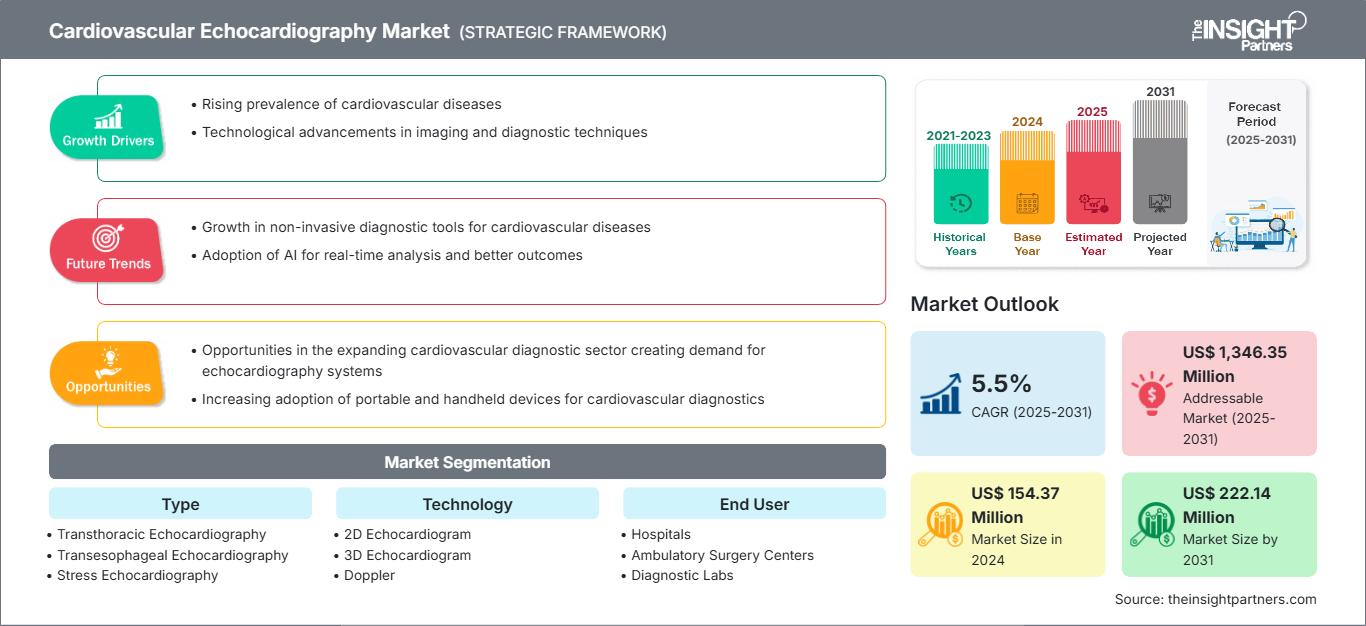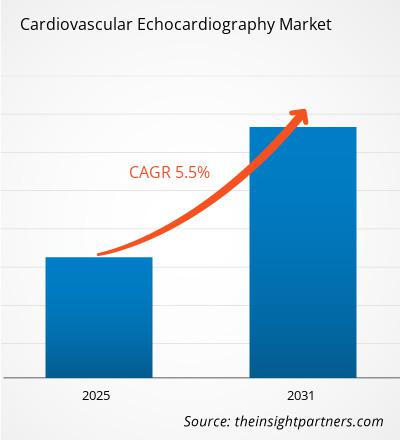[Rapport de recherche] Le marché de l'échocardiographie cardiovasculaire devrait atteindre 222,14 millions de dollars américains d'ici 2031, contre 154,37 millions de dollars américains en 2024 ; le marché devrait enregistrer un TCAC de 5,5 % entre 2025 et 2031.
Analyse du marché et point de vue des analystes :
L'échocardiographie cardiovasculaire est un type d'imagerie médicale permettant d'examiner le cœur. Elle utilise des ondes sonores pour créer des images visuelles du cœur. Ce test est généralement effectué sur des patients présentant des maladies cardiaques suspectées ou connues. Outre la révélation de la taille et de la forme des cavités et des valves, le test évalue également le fonctionnement cardiaque en calculant le débit cardiaque, la fraction d'éjection et la fonction diastolique. L'échocardiogramme cardiovasculaire peut également détecter les cardiomyopathies. Les lésions causées par une crise cardiaque antérieure peuvent être clairement visualisées à l'aide d'échocardiographes. L'échographie cardiaque transthoracique, transœsophagienne et de stress fait partie des différents examens d'échographie cardiaque pratiqués à des fins diagnostiques. La charge croissante des maladies cardiovasculaires et la croissance de la population gériatrique devraient créer de nombreuses opportunités de croissance pour le marché de l'échocardiographie cardiovasculaire.
Moteurs de croissance :
Lors de l'examen et de l'évaluation d'une crise cardiaque, d'une douleur thoracique, d'une coronaropathie, de caillots sanguins et d'autres troubles cardiaques, les médecins recommandent des traitements invasifs comprenant des analyses de sang et un cathétérisme cardiaque. Le cathétérisme cardiaque nécessite une hospitalisation prolongée et entraîne certains effets secondaires tels que des saignements, des caillots sanguins, des lésions artérielles et d'autres complications. Pour ces raisons, les médecins limitent généralement l'utilisation de cette procédure pour le diagnostic cardiaque et ont plutôt recours à l'épreuve d'effort cardiaque nucléaire, à l'imagerie par résonance magnétique, à l'échographie cardiaque et à l'angiographie coronarienne par tomodensitométrie, car ces procédures sont réalisées de manière non invasive.
L'échocardiographie est l'examen de diagnostic cardiovasculaire le plus couramment utilisé après l'électrocardiographie et la radiographie pulmonaire. Il s'agit d'une procédure diagnostique non invasive qui révèle des informations sur le fonctionnement cardiaque et l'hémodynamique. L'échocardiographie présente des risques minimes, voire nuls, par rapport à d'autres procédures diagnostiques utilisant des radiations, ce qui explique son adoption généralisée dans les hôpitaux et les centres de diagnostic. De plus, les patients ayant des antécédents d'insuffisance cardiaque bénéficient d'une surveillance régulière grâce à ces diagnostics cardiaques. Cela permet également de surveiller la maladie et l'efficacité du traitement ou de la chirurgie. L'échocardiographie est également utilisée dans le cadre des soins réguliers dispensés aux patients traités contre le cancer et présentant un risque de cardiotoxicité.
Les avantages liés à l'utilisation des appareils échocardiographiques par rapport aux autres procédures de diagnostic cardiaque favorisent leur adoption, stimulant ainsi la croissance du marché de l'échocardiographie cardiovasculaire.
Les tendances du marché de l'échocardiographie cardiovasculaire incluent l'intégration de l'IA et d'autres technologies innovantes dans les appareils d'échocardiographie.
Personnalisez ce rapport en fonction de vos besoins
Vous bénéficierez d’une personnalisation sur n’importe quel rapport - gratuitement - y compris des parties de ce rapport, ou une analyse au niveau du pays, un pack de données Excel, ainsi que de profiter d’offres exceptionnelles et de réductions pour les start-ups et les universités
Marché de l'échocardiographie cardiovasculaire: Perspectives stratégiques

-
Obtenez les principales tendances clés du marché de ce rapport.Cet échantillon GRATUIT comprendra une analyse de données, allant des tendances du marché aux estimations et prévisions.
Segmentation et portée du rapport :
L'analyse du marché de l'échocardiographie cardiovasculaire a été réalisée en prenant en compte les segments suivants : type, technologie, utilisateur final et géographie. En fonction du type, le marché est segmenté en échocardiographie transthoracique, échocardiographie transœsophagienne, échocardiographie de stress et échocardiographie fœtale. En termes de technologie, le marché est classé en échocardiogramme 2D, échocardiogramme 3D et Doppler. En fonction de l'utilisateur final, le marché est catégorisé en hôpitaux, centres de chirurgie ambulatoire et laboratoires de diagnostic. Le rapport sur le marché de l'échocardiographie cardiovasculaire couvre l'Amérique du Nord (États-Unis, Canada et Mexique), l'Europe (France, Allemagne, Royaume-Uni, Espagne, Italie et reste de l'Europe), l'Asie-Pacifique (Chine, Japon, Inde, Australie, Corée du Sud et reste de l'Asie-Pacifique), le Moyen-Orient et l'Afrique (Arabie saoudite, Afrique du Sud, Émirats arabes unis et reste du Moyen-Orient et de l'Afrique), et l'Afrique du Sud et Amérique centrale (Brésil, Argentine et reste de l'Amérique du Sud et centrale).
Analyse segmentaire :
Le marché de l'échocardiographie cardiovasculaire, par type, est classé en échocardiographie transthoracique, échocardiographie de stress, échocardiographie transœsophagienne et échocardiographie fœtale. Le segment de l'échocardiographie transthoracique détenait une part de marché importante en 2022. Il devrait enregistrer le TCAC le plus élevé du marché entre 2022 et 2030.
En fonction de la technologie, le marché est classé en échocardiogramme 2D, échocardiogramme 3D et Doppler. Le segment de l'échocardiogramme 3D détenait une part de marché importante en 2022 et devrait enregistrer le TCAC le plus élevé entre 2022 et 2030.
En fonction de l'utilisateur final, le marché est segmenté en hôpitaux, centres de chirurgie ambulatoire et laboratoires de diagnostic. Le segment des hôpitaux détenait une part de marché importante de l'échocardiographie cardiovasculaire en 2022 et devrait enregistrer le TCAC le plus élevé entre 2022 et 2030.
Aperçu régional du marché de l'échocardiographie cardiovasculaire
Les tendances régionales et les facteurs influençant le marché de l'échocardiographie cardiovasculaire tout au long de la période de prévision ont été analysés en détail par les analystes de The Insight Partners. Cette section aborde également les segments et la géographie du marché de l'échocardiographie cardiovasculaire en Amérique du Nord, en Europe, en Asie-Pacifique, au Moyen-Orient et en Afrique, ainsi qu'en Amérique du Sud et en Amérique centrale.
Portée du rapport sur le marché de l'échocardiographie cardiovasculaire
| Attribut de rapport | Détails |
|---|---|
| Taille du marché en 2024 | US$ 154.37 Million |
| Taille du marché par 2031 | US$ 222.14 Million |
| TCAC mondial (2025 - 2031) | 5.5% |
| Données historiques | 2021-2023 |
| Période de prévision | 2025-2031 |
| Segments couverts |
By Type
|
| Régions et pays couverts |
Amérique du Nord
|
| Leaders du marché et profils d'entreprises clés |
|
Densité des acteurs du marché de l'échocardiographie cardiovasculaire : comprendre son impact sur la dynamique commerciale
Le marché de l'échocardiographie cardiovasculaire connaît une croissance rapide, portée par une demande croissante des utilisateurs finaux, due à des facteurs tels que l'évolution des préférences des consommateurs, les avancées technologiques et une meilleure connaissance des avantages du produit. Face à cette demande croissante, les entreprises élargissent leur offre, innovent pour répondre aux besoins des consommateurs et capitalisent sur les nouvelles tendances, ce qui alimente la croissance du marché.

- Obtenez le Marché de l'échocardiographie cardiovasculaire Aperçu des principaux acteurs clés
- Analyse historique (2 ans), année de base, prévision (7 ans) avec TCAC
- Analyse PEST et SWOT
- Taille du marché Valeur / Volume - Mondial, Régional, Pays
- Industrie et paysage concurrentiel
- Ensemble de données Excel
Rapports récents
Témoignages
Raison d'acheter
- Prise de décision éclairée
- Compréhension de la dynamique du marché
- Analyse concurrentielle
- Connaissances clients
- Prévisions de marché
- Atténuation des risques
- Planification stratégique
- Justification des investissements
- Identification des marchés émergents
- Amélioration des stratégies marketing
- Amélioration de l'efficacité opérationnelle
- Alignement sur les tendances réglementaires






















 Obtenez un échantillon gratuit pour - Marché de l'échocardiographie cardiovasculaire
Obtenez un échantillon gratuit pour - Marché de l'échocardiographie cardiovasculaire